Constraints on Consumer Participation in Mental Health Care
VerifiedAdded on 2022/10/14
|14
|4155
|275
Essay
AI Summary
This essay critically evaluates the constraints that restrict consumer participation in mental health care services and their influence on the visibility of participation and application of recovery. It analyzes how hidden, unconscious, and ingrained ideologies impact consumer involvement in organizational planning and service delivery. The essay explores various factors, including inadequate feedback, lack of information, the use of restraints, patient confidentiality concerns, stigma, and centralization of health systems, which hinder consumer participation. It emphasizes the importance of the consumer's voice in mental health care, highlighting how it promotes recovery and person-centered care. The essay also discusses the role of recovery-oriented mental health services and the benefits of consumer participation in education and treatment planning, ultimately advocating for services that respect patient values and promote inclusive citizenship.

Running head: ESSAY
Written Assessment
Name of the Student
Name of the University
Author Note
Written Assessment
Name of the Student
Name of the University
Author Note
Paraphrase This Document
Need a fresh take? Get an instant paraphrase of this document with our AI Paraphraser
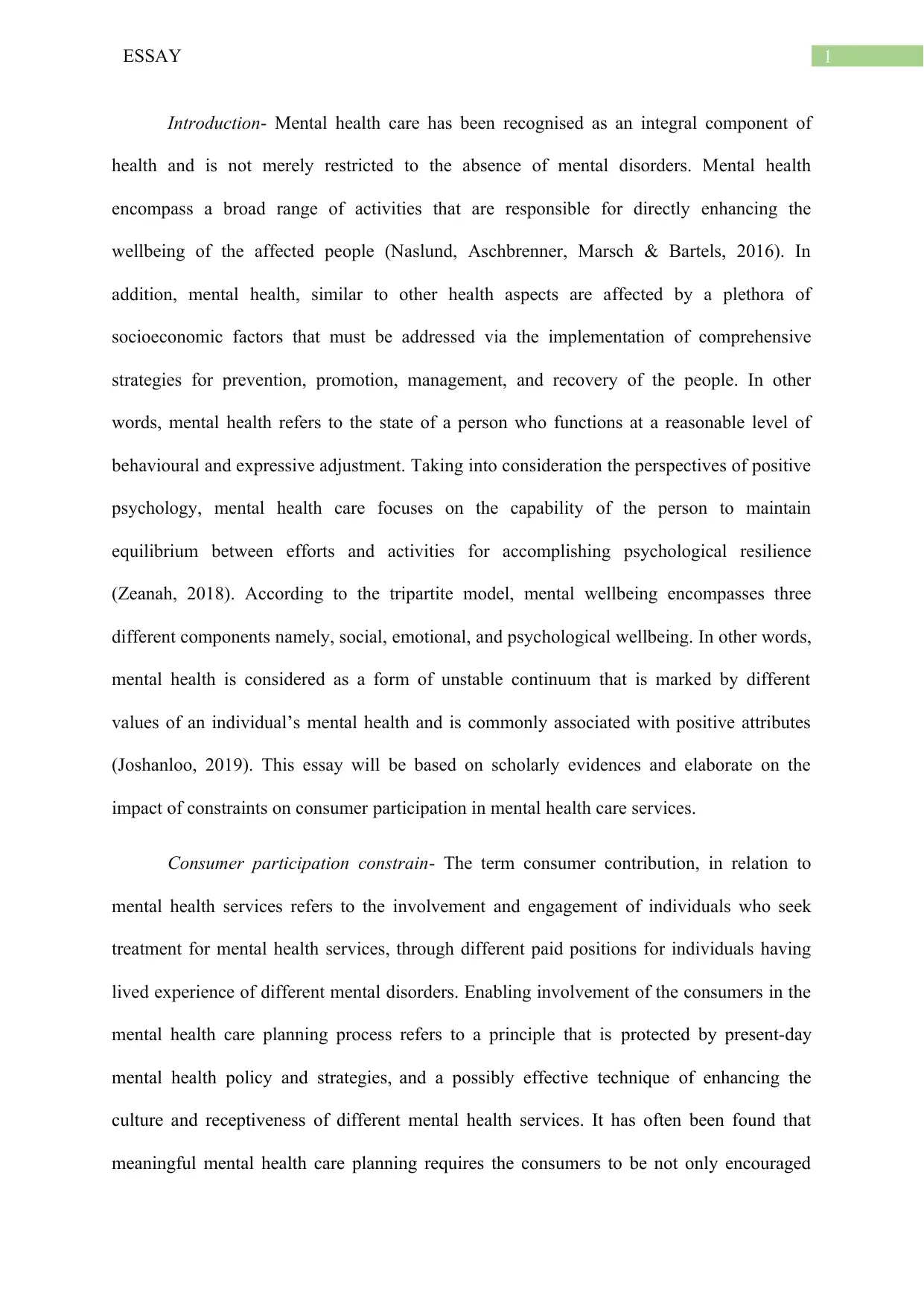
1ESSAY
Introduction- Mental health care has been recognised as an integral component of
health and is not merely restricted to the absence of mental disorders. Mental health
encompass a broad range of activities that are responsible for directly enhancing the
wellbeing of the affected people (Naslund, Aschbrenner, Marsch & Bartels, 2016). In
addition, mental health, similar to other health aspects are affected by a plethora of
socioeconomic factors that must be addressed via the implementation of comprehensive
strategies for prevention, promotion, management, and recovery of the people. In other
words, mental health refers to the state of a person who functions at a reasonable level of
behavioural and expressive adjustment. Taking into consideration the perspectives of positive
psychology, mental health care focuses on the capability of the person to maintain
equilibrium between efforts and activities for accomplishing psychological resilience
(Zeanah, 2018). According to the tripartite model, mental wellbeing encompasses three
different components namely, social, emotional, and psychological wellbeing. In other words,
mental health is considered as a form of unstable continuum that is marked by different
values of an individual’s mental health and is commonly associated with positive attributes
(Joshanloo, 2019). This essay will be based on scholarly evidences and elaborate on the
impact of constraints on consumer participation in mental health care services.
Consumer participation constrain- The term consumer contribution, in relation to
mental health services refers to the involvement and engagement of individuals who seek
treatment for mental health services, through different paid positions for individuals having
lived experience of different mental disorders. Enabling involvement of the consumers in the
mental health care planning process refers to a principle that is protected by present-day
mental health policy and strategies, and a possibly effective technique of enhancing the
culture and receptiveness of different mental health services. It has often been found that
meaningful mental health care planning requires the consumers to be not only encouraged
Introduction- Mental health care has been recognised as an integral component of
health and is not merely restricted to the absence of mental disorders. Mental health
encompass a broad range of activities that are responsible for directly enhancing the
wellbeing of the affected people (Naslund, Aschbrenner, Marsch & Bartels, 2016). In
addition, mental health, similar to other health aspects are affected by a plethora of
socioeconomic factors that must be addressed via the implementation of comprehensive
strategies for prevention, promotion, management, and recovery of the people. In other
words, mental health refers to the state of a person who functions at a reasonable level of
behavioural and expressive adjustment. Taking into consideration the perspectives of positive
psychology, mental health care focuses on the capability of the person to maintain
equilibrium between efforts and activities for accomplishing psychological resilience
(Zeanah, 2018). According to the tripartite model, mental wellbeing encompasses three
different components namely, social, emotional, and psychological wellbeing. In other words,
mental health is considered as a form of unstable continuum that is marked by different
values of an individual’s mental health and is commonly associated with positive attributes
(Joshanloo, 2019). This essay will be based on scholarly evidences and elaborate on the
impact of constraints on consumer participation in mental health care services.
Consumer participation constrain- The term consumer contribution, in relation to
mental health services refers to the involvement and engagement of individuals who seek
treatment for mental health services, through different paid positions for individuals having
lived experience of different mental disorders. Enabling involvement of the consumers in the
mental health care planning process refers to a principle that is protected by present-day
mental health policy and strategies, and a possibly effective technique of enhancing the
culture and receptiveness of different mental health services. It has often been found that
meaningful mental health care planning requires the consumers to be not only encouraged
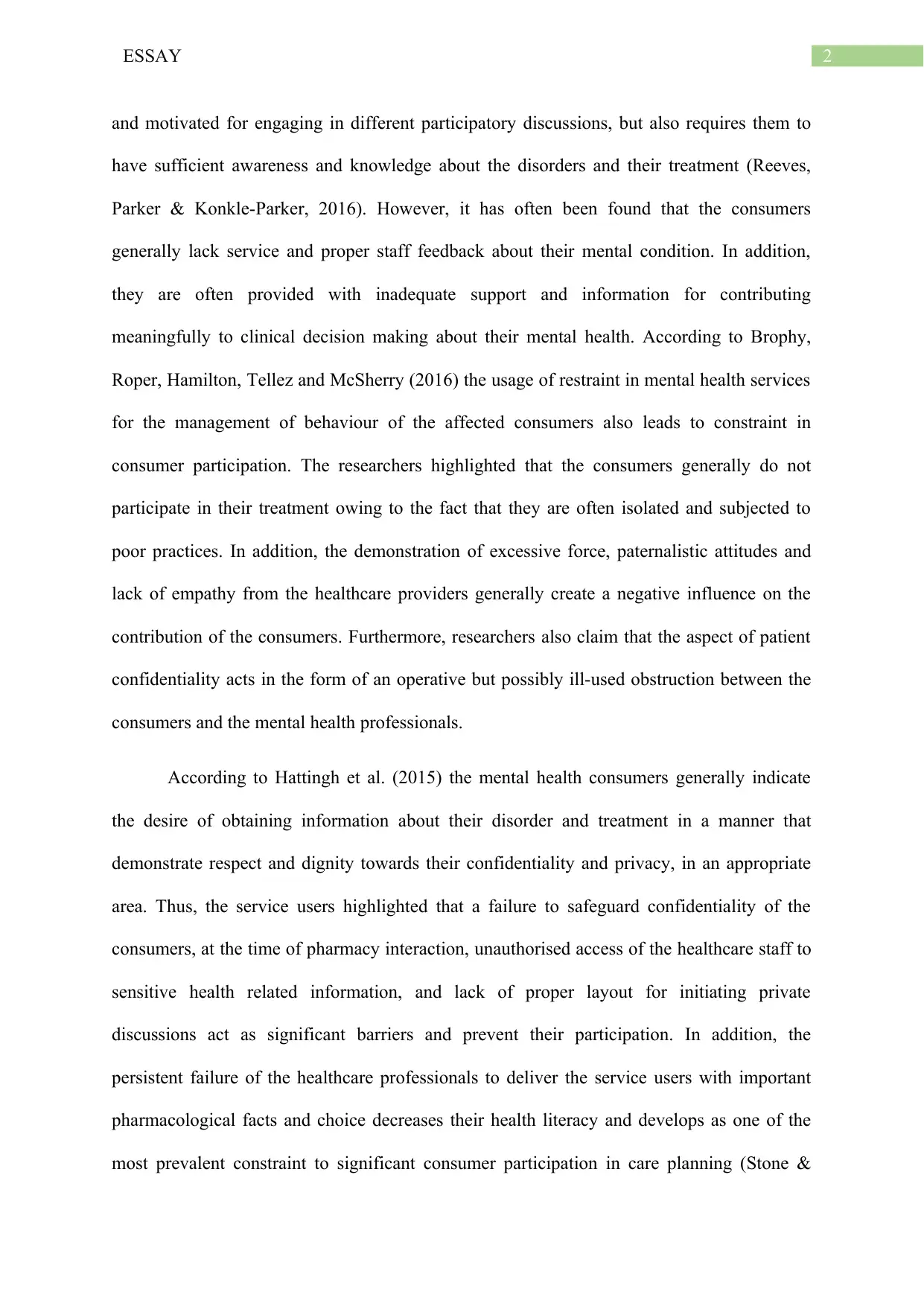
2ESSAY
and motivated for engaging in different participatory discussions, but also requires them to
have sufficient awareness and knowledge about the disorders and their treatment (Reeves,
Parker & Konkle-Parker, 2016). However, it has often been found that the consumers
generally lack service and proper staff feedback about their mental condition. In addition,
they are often provided with inadequate support and information for contributing
meaningfully to clinical decision making about their mental health. According to Brophy,
Roper, Hamilton, Tellez and McSherry (2016) the usage of restraint in mental health services
for the management of behaviour of the affected consumers also leads to constraint in
consumer participation. The researchers highlighted that the consumers generally do not
participate in their treatment owing to the fact that they are often isolated and subjected to
poor practices. In addition, the demonstration of excessive force, paternalistic attitudes and
lack of empathy from the healthcare providers generally create a negative influence on the
contribution of the consumers. Furthermore, researchers also claim that the aspect of patient
confidentiality acts in the form of an operative but possibly ill-used obstruction between the
consumers and the mental health professionals.
According to Hattingh et al. (2015) the mental health consumers generally indicate
the desire of obtaining information about their disorder and treatment in a manner that
demonstrate respect and dignity towards their confidentiality and privacy, in an appropriate
area. Thus, the service users highlighted that a failure to safeguard confidentiality of the
consumers, at the time of pharmacy interaction, unauthorised access of the healthcare staff to
sensitive health related information, and lack of proper layout for initiating private
discussions act as significant barriers and prevent their participation. In addition, the
persistent failure of the healthcare professionals to deliver the service users with important
pharmacological facts and choice decreases their health literacy and develops as one of the
most prevalent constraint to significant consumer participation in care planning (Stone &
and motivated for engaging in different participatory discussions, but also requires them to
have sufficient awareness and knowledge about the disorders and their treatment (Reeves,
Parker & Konkle-Parker, 2016). However, it has often been found that the consumers
generally lack service and proper staff feedback about their mental condition. In addition,
they are often provided with inadequate support and information for contributing
meaningfully to clinical decision making about their mental health. According to Brophy,
Roper, Hamilton, Tellez and McSherry (2016) the usage of restraint in mental health services
for the management of behaviour of the affected consumers also leads to constraint in
consumer participation. The researchers highlighted that the consumers generally do not
participate in their treatment owing to the fact that they are often isolated and subjected to
poor practices. In addition, the demonstration of excessive force, paternalistic attitudes and
lack of empathy from the healthcare providers generally create a negative influence on the
contribution of the consumers. Furthermore, researchers also claim that the aspect of patient
confidentiality acts in the form of an operative but possibly ill-used obstruction between the
consumers and the mental health professionals.
According to Hattingh et al. (2015) the mental health consumers generally indicate
the desire of obtaining information about their disorder and treatment in a manner that
demonstrate respect and dignity towards their confidentiality and privacy, in an appropriate
area. Thus, the service users highlighted that a failure to safeguard confidentiality of the
consumers, at the time of pharmacy interaction, unauthorised access of the healthcare staff to
sensitive health related information, and lack of proper layout for initiating private
discussions act as significant barriers and prevent their participation. In addition, the
persistent failure of the healthcare professionals to deliver the service users with important
pharmacological facts and choice decreases their health literacy and develops as one of the
most prevalent constraint to significant consumer participation in care planning (Stone &
⊘ This is a preview!⊘
Do you want full access?
Subscribe today to unlock all pages.

Trusted by 1+ million students worldwide
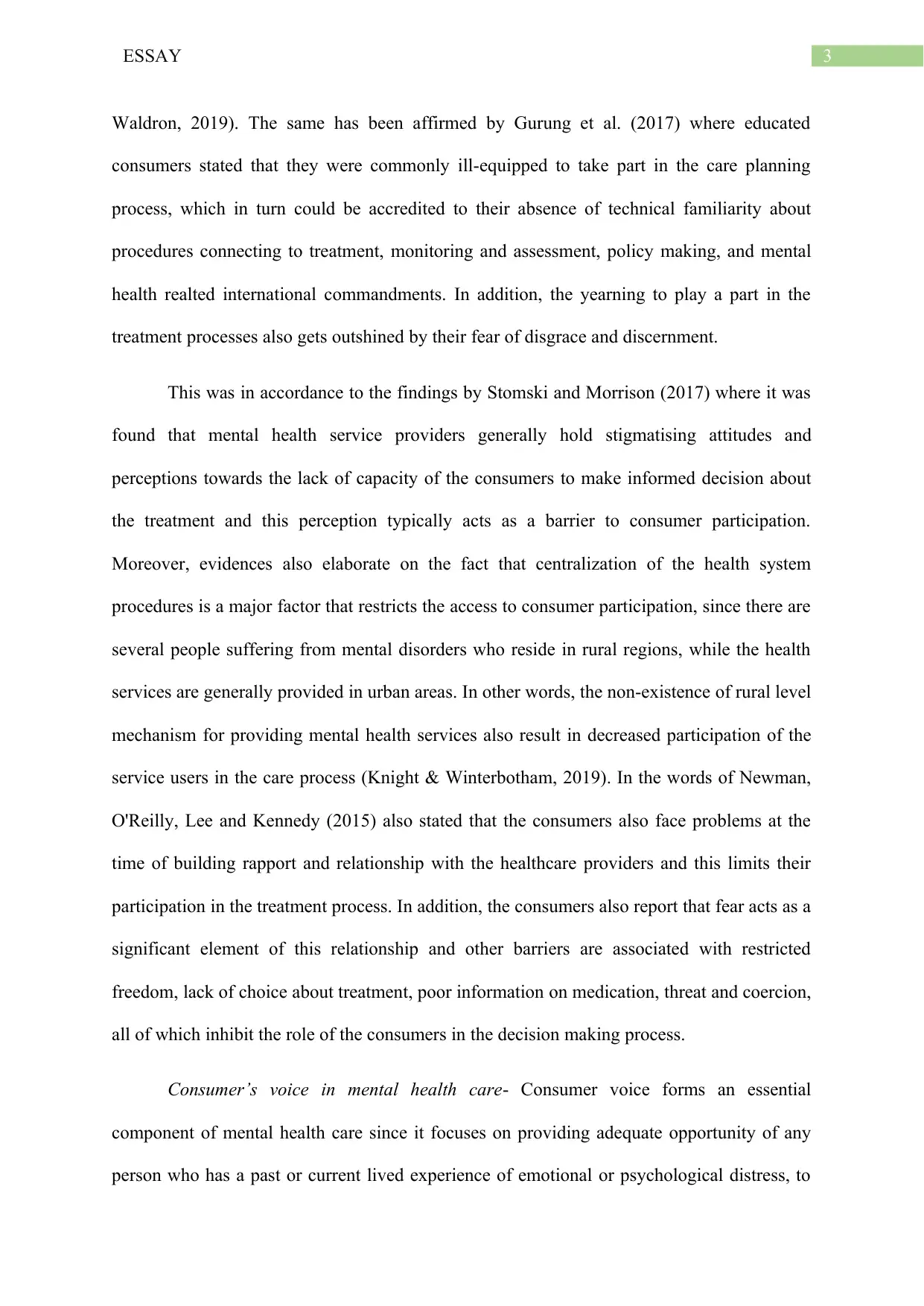
3ESSAY
Waldron, 2019). The same has been affirmed by Gurung et al. (2017) where educated
consumers stated that they were commonly ill-equipped to take part in the care planning
process, which in turn could be accredited to their absence of technical familiarity about
procedures connecting to treatment, monitoring and assessment, policy making, and mental
health realted international commandments. In addition, the yearning to play a part in the
treatment processes also gets outshined by their fear of disgrace and discernment.
This was in accordance to the findings by Stomski and Morrison (2017) where it was
found that mental health service providers generally hold stigmatising attitudes and
perceptions towards the lack of capacity of the consumers to make informed decision about
the treatment and this perception typically acts as a barrier to consumer participation.
Moreover, evidences also elaborate on the fact that centralization of the health system
procedures is a major factor that restricts the access to consumer participation, since there are
several people suffering from mental disorders who reside in rural regions, while the health
services are generally provided in urban areas. In other words, the non-existence of rural level
mechanism for providing mental health services also result in decreased participation of the
service users in the care process (Knight & Winterbotham, 2019). In the words of Newman,
O'Reilly, Lee and Kennedy (2015) also stated that the consumers also face problems at the
time of building rapport and relationship with the healthcare providers and this limits their
participation in the treatment process. In addition, the consumers also report that fear acts as a
significant element of this relationship and other barriers are associated with restricted
freedom, lack of choice about treatment, poor information on medication, threat and coercion,
all of which inhibit the role of the consumers in the decision making process.
Consumer’s voice in mental health care- Consumer voice forms an essential
component of mental health care since it focuses on providing adequate opportunity of any
person who has a past or current lived experience of emotional or psychological distress, to
Waldron, 2019). The same has been affirmed by Gurung et al. (2017) where educated
consumers stated that they were commonly ill-equipped to take part in the care planning
process, which in turn could be accredited to their absence of technical familiarity about
procedures connecting to treatment, monitoring and assessment, policy making, and mental
health realted international commandments. In addition, the yearning to play a part in the
treatment processes also gets outshined by their fear of disgrace and discernment.
This was in accordance to the findings by Stomski and Morrison (2017) where it was
found that mental health service providers generally hold stigmatising attitudes and
perceptions towards the lack of capacity of the consumers to make informed decision about
the treatment and this perception typically acts as a barrier to consumer participation.
Moreover, evidences also elaborate on the fact that centralization of the health system
procedures is a major factor that restricts the access to consumer participation, since there are
several people suffering from mental disorders who reside in rural regions, while the health
services are generally provided in urban areas. In other words, the non-existence of rural level
mechanism for providing mental health services also result in decreased participation of the
service users in the care process (Knight & Winterbotham, 2019). In the words of Newman,
O'Reilly, Lee and Kennedy (2015) also stated that the consumers also face problems at the
time of building rapport and relationship with the healthcare providers and this limits their
participation in the treatment process. In addition, the consumers also report that fear acts as a
significant element of this relationship and other barriers are associated with restricted
freedom, lack of choice about treatment, poor information on medication, threat and coercion,
all of which inhibit the role of the consumers in the decision making process.
Consumer’s voice in mental health care- Consumer voice forms an essential
component of mental health care since it focuses on providing adequate opportunity of any
person who has a past or current lived experience of emotional or psychological distress, to
Paraphrase This Document
Need a fresh take? Get an instant paraphrase of this document with our AI Paraphraser
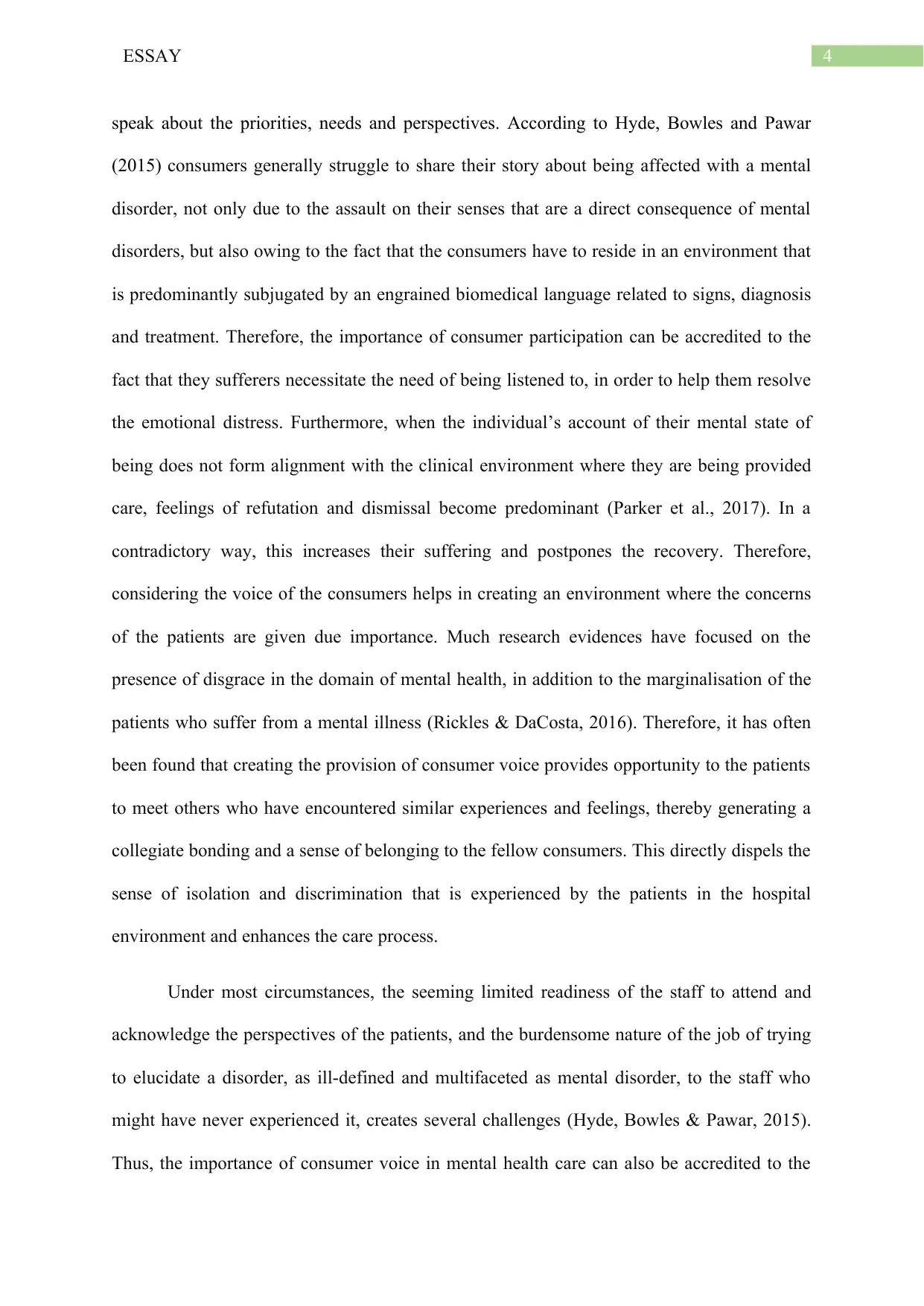
4ESSAY
speak about the priorities, needs and perspectives. According to Hyde, Bowles and Pawar
(2015) consumers generally struggle to share their story about being affected with a mental
disorder, not only due to the assault on their senses that are a direct consequence of mental
disorders, but also owing to the fact that the consumers have to reside in an environment that
is predominantly subjugated by an engrained biomedical language related to signs, diagnosis
and treatment. Therefore, the importance of consumer participation can be accredited to the
fact that they sufferers necessitate the need of being listened to, in order to help them resolve
the emotional distress. Furthermore, when the individual’s account of their mental state of
being does not form alignment with the clinical environment where they are being provided
care, feelings of refutation and dismissal become predominant (Parker et al., 2017). In a
contradictory way, this increases their suffering and postpones the recovery. Therefore,
considering the voice of the consumers helps in creating an environment where the concerns
of the patients are given due importance. Much research evidences have focused on the
presence of disgrace in the domain of mental health, in addition to the marginalisation of the
patients who suffer from a mental illness (Rickles & DaCosta, 2016). Therefore, it has often
been found that creating the provision of consumer voice provides opportunity to the patients
to meet others who have encountered similar experiences and feelings, thereby generating a
collegiate bonding and a sense of belonging to the fellow consumers. This directly dispels the
sense of isolation and discrimination that is experienced by the patients in the hospital
environment and enhances the care process.
Under most circumstances, the seeming limited readiness of the staff to attend and
acknowledge the perspectives of the patients, and the burdensome nature of the job of trying
to elucidate a disorder, as ill-defined and multifaceted as mental disorder, to the staff who
might have never experienced it, creates several challenges (Hyde, Bowles & Pawar, 2015).
Thus, the importance of consumer voice in mental health care can also be accredited to the
speak about the priorities, needs and perspectives. According to Hyde, Bowles and Pawar
(2015) consumers generally struggle to share their story about being affected with a mental
disorder, not only due to the assault on their senses that are a direct consequence of mental
disorders, but also owing to the fact that the consumers have to reside in an environment that
is predominantly subjugated by an engrained biomedical language related to signs, diagnosis
and treatment. Therefore, the importance of consumer participation can be accredited to the
fact that they sufferers necessitate the need of being listened to, in order to help them resolve
the emotional distress. Furthermore, when the individual’s account of their mental state of
being does not form alignment with the clinical environment where they are being provided
care, feelings of refutation and dismissal become predominant (Parker et al., 2017). In a
contradictory way, this increases their suffering and postpones the recovery. Therefore,
considering the voice of the consumers helps in creating an environment where the concerns
of the patients are given due importance. Much research evidences have focused on the
presence of disgrace in the domain of mental health, in addition to the marginalisation of the
patients who suffer from a mental illness (Rickles & DaCosta, 2016). Therefore, it has often
been found that creating the provision of consumer voice provides opportunity to the patients
to meet others who have encountered similar experiences and feelings, thereby generating a
collegiate bonding and a sense of belonging to the fellow consumers. This directly dispels the
sense of isolation and discrimination that is experienced by the patients in the hospital
environment and enhances the care process.
Under most circumstances, the seeming limited readiness of the staff to attend and
acknowledge the perspectives of the patients, and the burdensome nature of the job of trying
to elucidate a disorder, as ill-defined and multifaceted as mental disorder, to the staff who
might have never experienced it, creates several challenges (Hyde, Bowles & Pawar, 2015).
Thus, the importance of consumer voice in mental health care can also be accredited to the
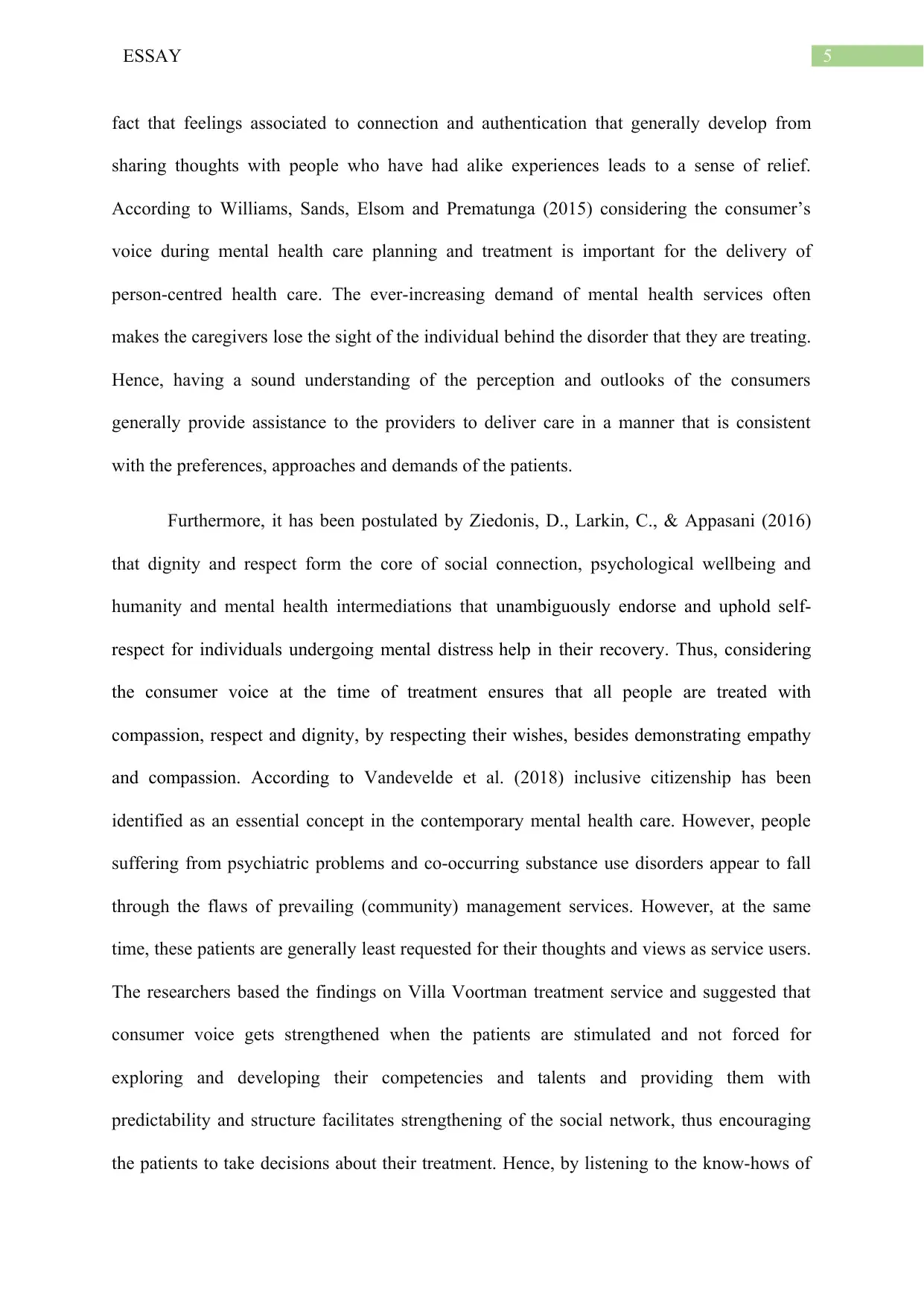
5ESSAY
fact that feelings associated to connection and authentication that generally develop from
sharing thoughts with people who have had alike experiences leads to a sense of relief.
According to Williams, Sands, Elsom and Prematunga (2015) considering the consumer’s
voice during mental health care planning and treatment is important for the delivery of
person-centred health care. The ever-increasing demand of mental health services often
makes the caregivers lose the sight of the individual behind the disorder that they are treating.
Hence, having a sound understanding of the perception and outlooks of the consumers
generally provide assistance to the providers to deliver care in a manner that is consistent
with the preferences, approaches and demands of the patients.
Furthermore, it has been postulated by Ziedonis, D., Larkin, C., & Appasani (2016)
that dignity and respect form the core of social connection, psychological wellbeing and
humanity and mental health intermediations that unambiguously endorse and uphold self-
respect for individuals undergoing mental distress help in their recovery. Thus, considering
the consumer voice at the time of treatment ensures that all people are treated with
compassion, respect and dignity, by respecting their wishes, besides demonstrating empathy
and compassion. According to Vandevelde et al. (2018) inclusive citizenship has been
identified as an essential concept in the contemporary mental health care. However, people
suffering from psychiatric problems and co-occurring substance use disorders appear to fall
through the flaws of prevailing (community) management services. However, at the same
time, these patients are generally least requested for their thoughts and views as service users.
The researchers based the findings on Villa Voortman treatment service and suggested that
consumer voice gets strengthened when the patients are stimulated and not forced for
exploring and developing their competencies and talents and providing them with
predictability and structure facilitates strengthening of the social network, thus encouraging
the patients to take decisions about their treatment. Hence, by listening to the know-hows of
fact that feelings associated to connection and authentication that generally develop from
sharing thoughts with people who have had alike experiences leads to a sense of relief.
According to Williams, Sands, Elsom and Prematunga (2015) considering the consumer’s
voice during mental health care planning and treatment is important for the delivery of
person-centred health care. The ever-increasing demand of mental health services often
makes the caregivers lose the sight of the individual behind the disorder that they are treating.
Hence, having a sound understanding of the perception and outlooks of the consumers
generally provide assistance to the providers to deliver care in a manner that is consistent
with the preferences, approaches and demands of the patients.
Furthermore, it has been postulated by Ziedonis, D., Larkin, C., & Appasani (2016)
that dignity and respect form the core of social connection, psychological wellbeing and
humanity and mental health intermediations that unambiguously endorse and uphold self-
respect for individuals undergoing mental distress help in their recovery. Thus, considering
the consumer voice at the time of treatment ensures that all people are treated with
compassion, respect and dignity, by respecting their wishes, besides demonstrating empathy
and compassion. According to Vandevelde et al. (2018) inclusive citizenship has been
identified as an essential concept in the contemporary mental health care. However, people
suffering from psychiatric problems and co-occurring substance use disorders appear to fall
through the flaws of prevailing (community) management services. However, at the same
time, these patients are generally least requested for their thoughts and views as service users.
The researchers based the findings on Villa Voortman treatment service and suggested that
consumer voice gets strengthened when the patients are stimulated and not forced for
exploring and developing their competencies and talents and providing them with
predictability and structure facilitates strengthening of the social network, thus encouraging
the patients to take decisions about their treatment. Hence, by listening to the know-hows of
⊘ This is a preview!⊘
Do you want full access?
Subscribe today to unlock all pages.

Trusted by 1+ million students worldwide
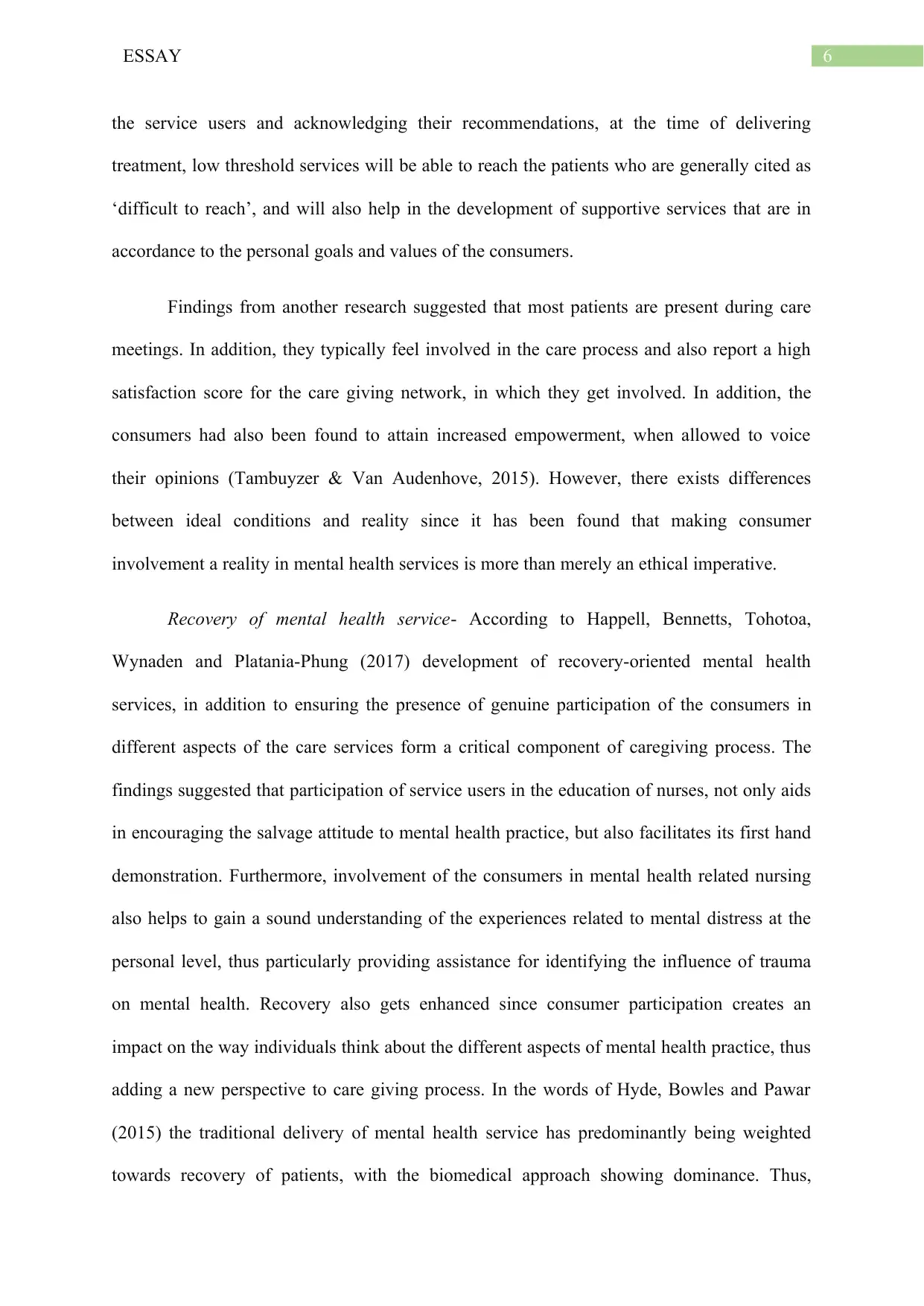
6ESSAY
the service users and acknowledging their recommendations, at the time of delivering
treatment, low threshold services will be able to reach the patients who are generally cited as
‘difficult to reach’, and will also help in the development of supportive services that are in
accordance to the personal goals and values of the consumers.
Findings from another research suggested that most patients are present during care
meetings. In addition, they typically feel involved in the care process and also report a high
satisfaction score for the care giving network, in which they get involved. In addition, the
consumers had also been found to attain increased empowerment, when allowed to voice
their opinions (Tambuyzer & Van Audenhove, 2015). However, there exists differences
between ideal conditions and reality since it has been found that making consumer
involvement a reality in mental health services is more than merely an ethical imperative.
Recovery of mental health service- According to Happell, Bennetts, Tohotoa,
Wynaden and Platania-Phung (2017) development of recovery-oriented mental health
services, in addition to ensuring the presence of genuine participation of the consumers in
different aspects of the care services form a critical component of caregiving process. The
findings suggested that participation of service users in the education of nurses, not only aids
in encouraging the salvage attitude to mental health practice, but also facilitates its first hand
demonstration. Furthermore, involvement of the consumers in mental health related nursing
also helps to gain a sound understanding of the experiences related to mental distress at the
personal level, thus particularly providing assistance for identifying the influence of trauma
on mental health. Recovery also gets enhanced since consumer participation creates an
impact on the way individuals think about the different aspects of mental health practice, thus
adding a new perspective to care giving process. In the words of Hyde, Bowles and Pawar
(2015) the traditional delivery of mental health service has predominantly being weighted
towards recovery of patients, with the biomedical approach showing dominance. Thus,
the service users and acknowledging their recommendations, at the time of delivering
treatment, low threshold services will be able to reach the patients who are generally cited as
‘difficult to reach’, and will also help in the development of supportive services that are in
accordance to the personal goals and values of the consumers.
Findings from another research suggested that most patients are present during care
meetings. In addition, they typically feel involved in the care process and also report a high
satisfaction score for the care giving network, in which they get involved. In addition, the
consumers had also been found to attain increased empowerment, when allowed to voice
their opinions (Tambuyzer & Van Audenhove, 2015). However, there exists differences
between ideal conditions and reality since it has been found that making consumer
involvement a reality in mental health services is more than merely an ethical imperative.
Recovery of mental health service- According to Happell, Bennetts, Tohotoa,
Wynaden and Platania-Phung (2017) development of recovery-oriented mental health
services, in addition to ensuring the presence of genuine participation of the consumers in
different aspects of the care services form a critical component of caregiving process. The
findings suggested that participation of service users in the education of nurses, not only aids
in encouraging the salvage attitude to mental health practice, but also facilitates its first hand
demonstration. Furthermore, involvement of the consumers in mental health related nursing
also helps to gain a sound understanding of the experiences related to mental distress at the
personal level, thus particularly providing assistance for identifying the influence of trauma
on mental health. Recovery also gets enhanced since consumer participation creates an
impact on the way individuals think about the different aspects of mental health practice, thus
adding a new perspective to care giving process. In the words of Hyde, Bowles and Pawar
(2015) the traditional delivery of mental health service has predominantly being weighted
towards recovery of patients, with the biomedical approach showing dominance. Thus,
Paraphrase This Document
Need a fresh take? Get an instant paraphrase of this document with our AI Paraphraser
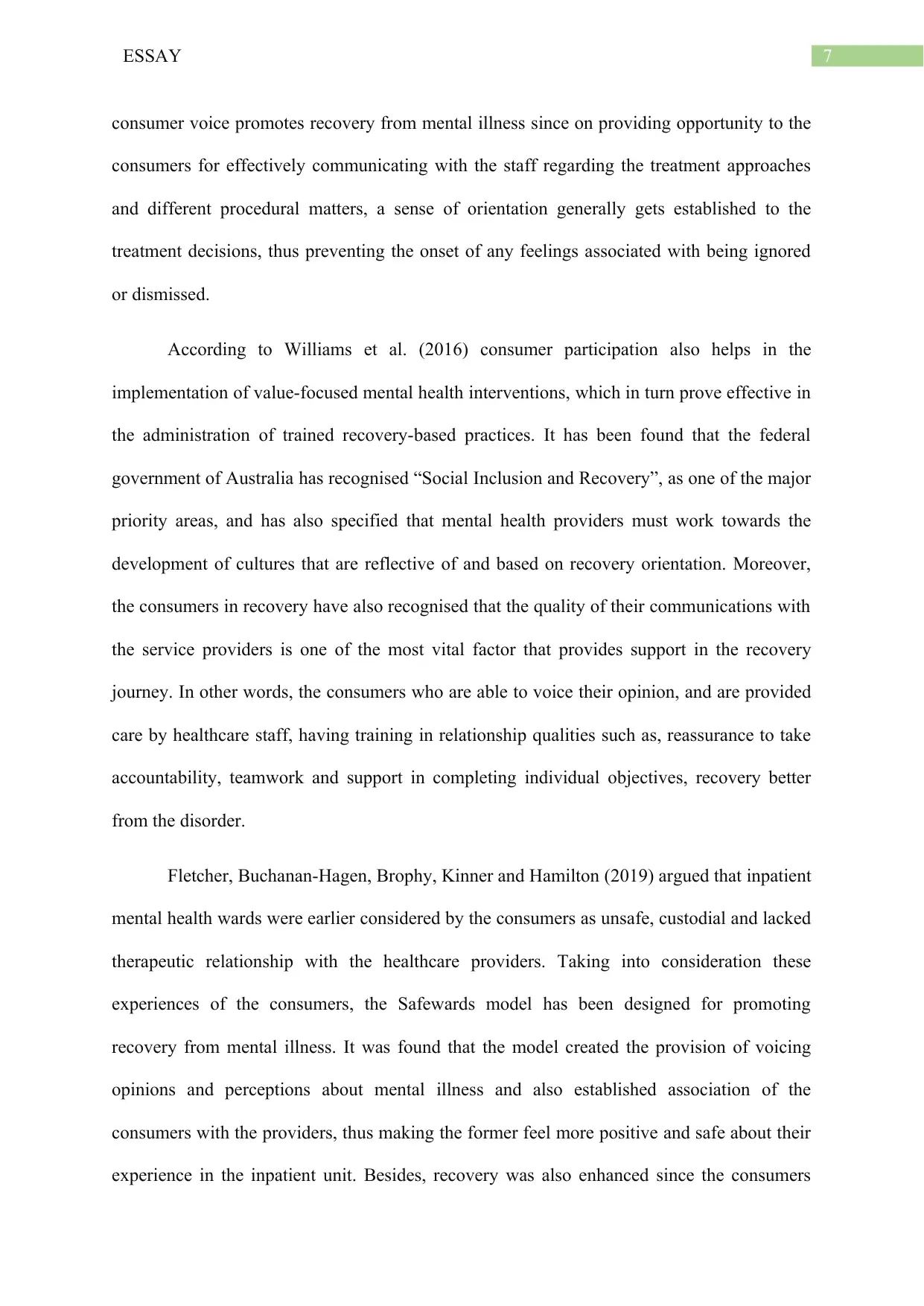
7ESSAY
consumer voice promotes recovery from mental illness since on providing opportunity to the
consumers for effectively communicating with the staff regarding the treatment approaches
and different procedural matters, a sense of orientation generally gets established to the
treatment decisions, thus preventing the onset of any feelings associated with being ignored
or dismissed.
According to Williams et al. (2016) consumer participation also helps in the
implementation of value-focused mental health interventions, which in turn prove effective in
the administration of trained recovery-based practices. It has been found that the federal
government of Australia has recognised “Social Inclusion and Recovery”, as one of the major
priority areas, and has also specified that mental health providers must work towards the
development of cultures that are reflective of and based on recovery orientation. Moreover,
the consumers in recovery have also recognised that the quality of their communications with
the service providers is one of the most vital factor that provides support in the recovery
journey. In other words, the consumers who are able to voice their opinion, and are provided
care by healthcare staff, having training in relationship qualities such as, reassurance to take
accountability, teamwork and support in completing individual objectives, recovery better
from the disorder.
Fletcher, Buchanan-Hagen, Brophy, Kinner and Hamilton (2019) argued that inpatient
mental health wards were earlier considered by the consumers as unsafe, custodial and lacked
therapeutic relationship with the healthcare providers. Taking into consideration these
experiences of the consumers, the Safewards model has been designed for promoting
recovery from mental illness. It was found that the model created the provision of voicing
opinions and perceptions about mental illness and also established association of the
consumers with the providers, thus making the former feel more positive and safe about their
experience in the inpatient unit. Besides, recovery was also enhanced since the consumers
consumer voice promotes recovery from mental illness since on providing opportunity to the
consumers for effectively communicating with the staff regarding the treatment approaches
and different procedural matters, a sense of orientation generally gets established to the
treatment decisions, thus preventing the onset of any feelings associated with being ignored
or dismissed.
According to Williams et al. (2016) consumer participation also helps in the
implementation of value-focused mental health interventions, which in turn prove effective in
the administration of trained recovery-based practices. It has been found that the federal
government of Australia has recognised “Social Inclusion and Recovery”, as one of the major
priority areas, and has also specified that mental health providers must work towards the
development of cultures that are reflective of and based on recovery orientation. Moreover,
the consumers in recovery have also recognised that the quality of their communications with
the service providers is one of the most vital factor that provides support in the recovery
journey. In other words, the consumers who are able to voice their opinion, and are provided
care by healthcare staff, having training in relationship qualities such as, reassurance to take
accountability, teamwork and support in completing individual objectives, recovery better
from the disorder.
Fletcher, Buchanan-Hagen, Brophy, Kinner and Hamilton (2019) argued that inpatient
mental health wards were earlier considered by the consumers as unsafe, custodial and lacked
therapeutic relationship with the healthcare providers. Taking into consideration these
experiences of the consumers, the Safewards model has been designed for promoting
recovery from mental illness. It was found that the model created the provision of voicing
opinions and perceptions about mental illness and also established association of the
consumers with the providers, thus making the former feel more positive and safe about their
experience in the inpatient unit. Besides, recovery was also enhanced since the consumers
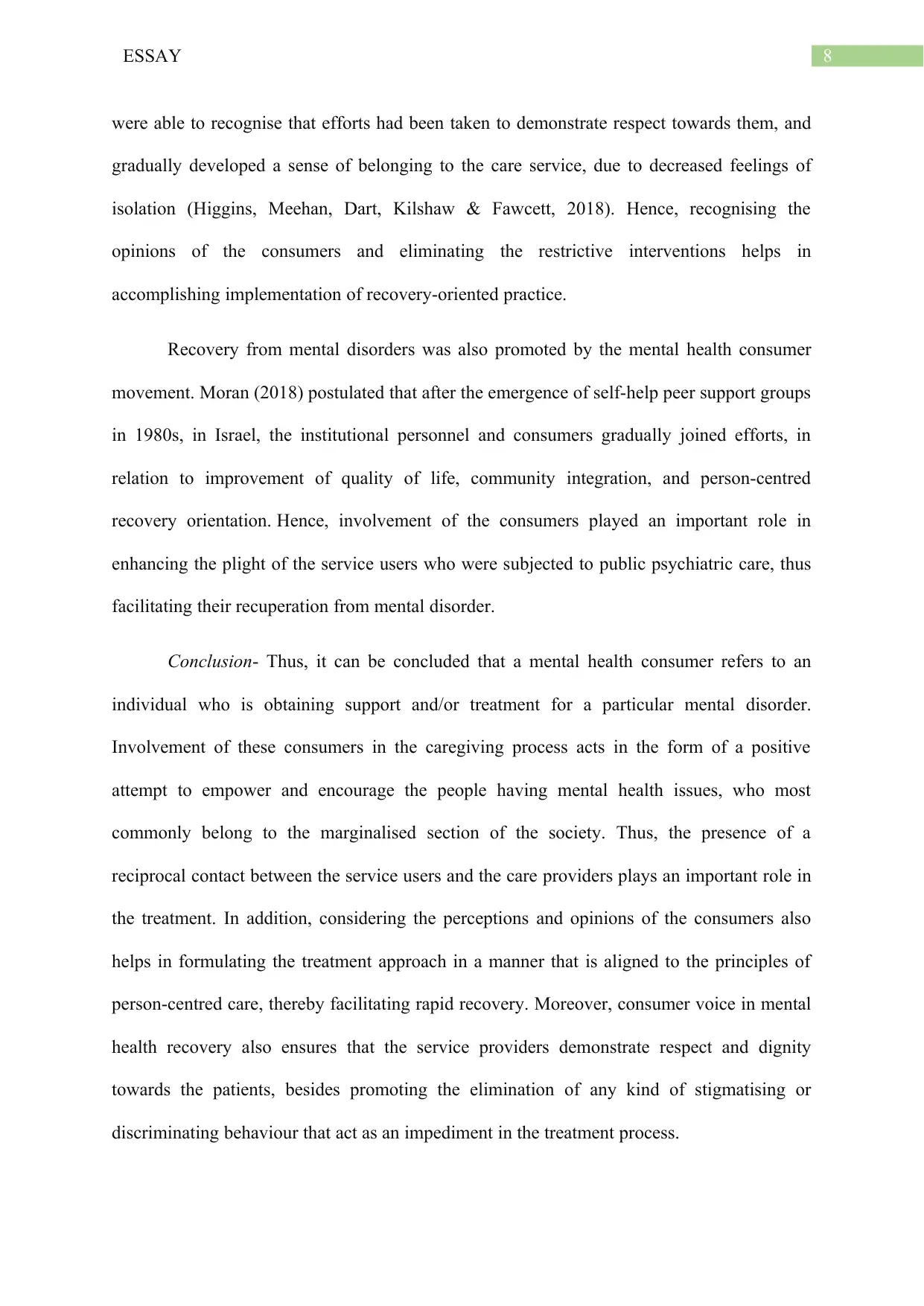
8ESSAY
were able to recognise that efforts had been taken to demonstrate respect towards them, and
gradually developed a sense of belonging to the care service, due to decreased feelings of
isolation (Higgins, Meehan, Dart, Kilshaw & Fawcett, 2018). Hence, recognising the
opinions of the consumers and eliminating the restrictive interventions helps in
accomplishing implementation of recovery-oriented practice.
Recovery from mental disorders was also promoted by the mental health consumer
movement. Moran (2018) postulated that after the emergence of self-help peer support groups
in 1980s, in Israel, the institutional personnel and consumers gradually joined efforts, in
relation to improvement of quality of life, community integration, and person-centred
recovery orientation. Hence, involvement of the consumers played an important role in
enhancing the plight of the service users who were subjected to public psychiatric care, thus
facilitating their recuperation from mental disorder.
Conclusion- Thus, it can be concluded that a mental health consumer refers to an
individual who is obtaining support and/or treatment for a particular mental disorder.
Involvement of these consumers in the caregiving process acts in the form of a positive
attempt to empower and encourage the people having mental health issues, who most
commonly belong to the marginalised section of the society. Thus, the presence of a
reciprocal contact between the service users and the care providers plays an important role in
the treatment. In addition, considering the perceptions and opinions of the consumers also
helps in formulating the treatment approach in a manner that is aligned to the principles of
person-centred care, thereby facilitating rapid recovery. Moreover, consumer voice in mental
health recovery also ensures that the service providers demonstrate respect and dignity
towards the patients, besides promoting the elimination of any kind of stigmatising or
discriminating behaviour that act as an impediment in the treatment process.
were able to recognise that efforts had been taken to demonstrate respect towards them, and
gradually developed a sense of belonging to the care service, due to decreased feelings of
isolation (Higgins, Meehan, Dart, Kilshaw & Fawcett, 2018). Hence, recognising the
opinions of the consumers and eliminating the restrictive interventions helps in
accomplishing implementation of recovery-oriented practice.
Recovery from mental disorders was also promoted by the mental health consumer
movement. Moran (2018) postulated that after the emergence of self-help peer support groups
in 1980s, in Israel, the institutional personnel and consumers gradually joined efforts, in
relation to improvement of quality of life, community integration, and person-centred
recovery orientation. Hence, involvement of the consumers played an important role in
enhancing the plight of the service users who were subjected to public psychiatric care, thus
facilitating their recuperation from mental disorder.
Conclusion- Thus, it can be concluded that a mental health consumer refers to an
individual who is obtaining support and/or treatment for a particular mental disorder.
Involvement of these consumers in the caregiving process acts in the form of a positive
attempt to empower and encourage the people having mental health issues, who most
commonly belong to the marginalised section of the society. Thus, the presence of a
reciprocal contact between the service users and the care providers plays an important role in
the treatment. In addition, considering the perceptions and opinions of the consumers also
helps in formulating the treatment approach in a manner that is aligned to the principles of
person-centred care, thereby facilitating rapid recovery. Moreover, consumer voice in mental
health recovery also ensures that the service providers demonstrate respect and dignity
towards the patients, besides promoting the elimination of any kind of stigmatising or
discriminating behaviour that act as an impediment in the treatment process.
⊘ This is a preview!⊘
Do you want full access?
Subscribe today to unlock all pages.

Trusted by 1+ million students worldwide

9ESSAY
Paraphrase This Document
Need a fresh take? Get an instant paraphrase of this document with our AI Paraphraser
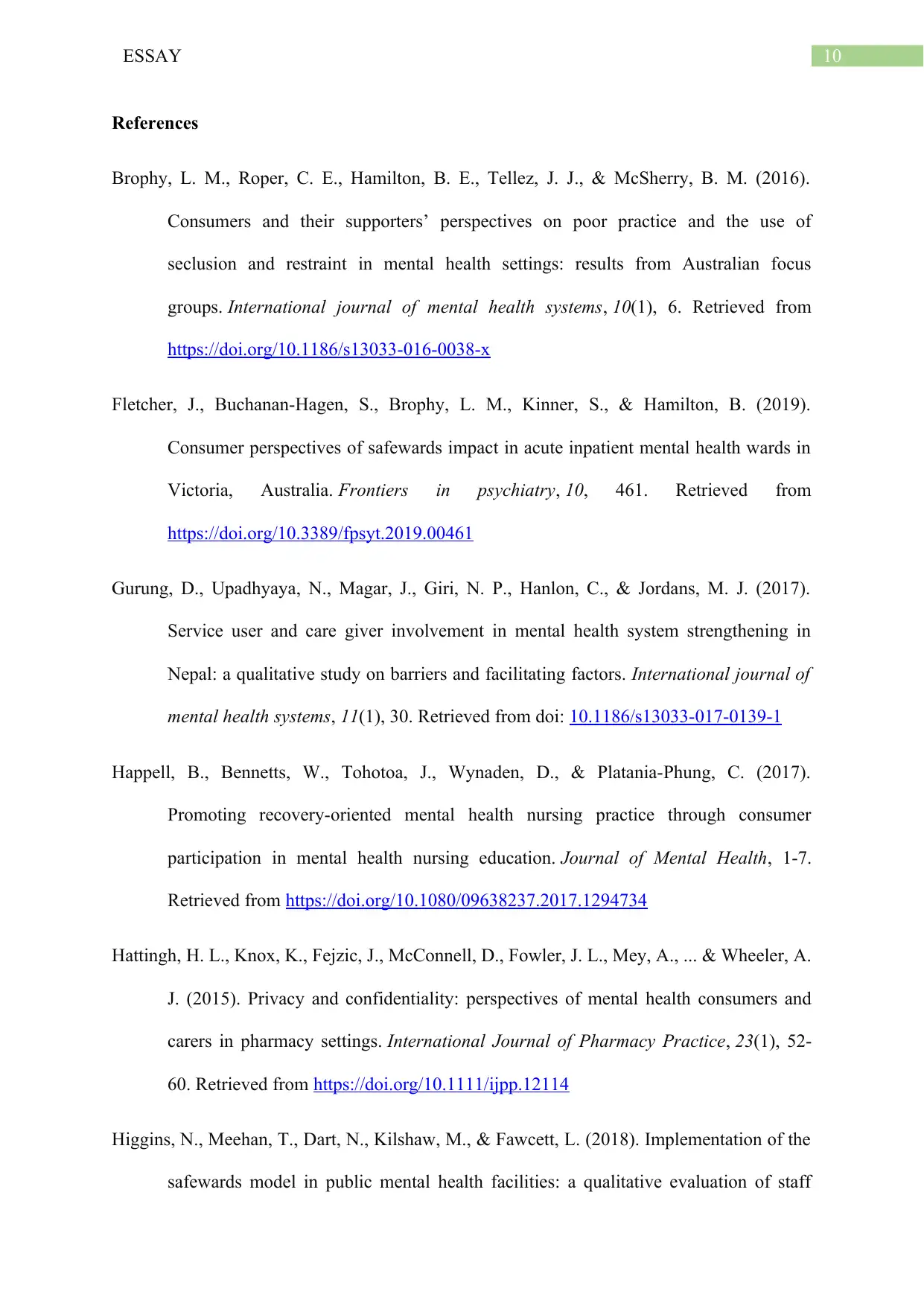
10ESSAY
References
Brophy, L. M., Roper, C. E., Hamilton, B. E., Tellez, J. J., & McSherry, B. M. (2016).
Consumers and their supporters’ perspectives on poor practice and the use of
seclusion and restraint in mental health settings: results from Australian focus
groups. International journal of mental health systems, 10(1), 6. Retrieved from
https://doi.org/10.1186/s13033-016-0038-x
Fletcher, J., Buchanan-Hagen, S., Brophy, L. M., Kinner, S., & Hamilton, B. (2019).
Consumer perspectives of safewards impact in acute inpatient mental health wards in
Victoria, Australia. Frontiers in psychiatry, 10, 461. Retrieved from
https://doi.org/10.3389/fpsyt.2019.00461
Gurung, D., Upadhyaya, N., Magar, J., Giri, N. P., Hanlon, C., & Jordans, M. J. (2017).
Service user and care giver involvement in mental health system strengthening in
Nepal: a qualitative study on barriers and facilitating factors. International journal of
mental health systems, 11(1), 30. Retrieved from doi: 10.1186/s13033-017-0139-1
Happell, B., Bennetts, W., Tohotoa, J., Wynaden, D., & Platania-Phung, C. (2017).
Promoting recovery-oriented mental health nursing practice through consumer
participation in mental health nursing education. Journal of Mental Health, 1-7.
Retrieved from https://doi.org/10.1080/09638237.2017.1294734
Hattingh, H. L., Knox, K., Fejzic, J., McConnell, D., Fowler, J. L., Mey, A., ... & Wheeler, A.
J. (2015). Privacy and confidentiality: perspectives of mental health consumers and
carers in pharmacy settings. International Journal of Pharmacy Practice, 23(1), 52-
60. Retrieved from https://doi.org/10.1111/ijpp.12114
Higgins, N., Meehan, T., Dart, N., Kilshaw, M., & Fawcett, L. (2018). Implementation of the
safewards model in public mental health facilities: a qualitative evaluation of staff
References
Brophy, L. M., Roper, C. E., Hamilton, B. E., Tellez, J. J., & McSherry, B. M. (2016).
Consumers and their supporters’ perspectives on poor practice and the use of
seclusion and restraint in mental health settings: results from Australian focus
groups. International journal of mental health systems, 10(1), 6. Retrieved from
https://doi.org/10.1186/s13033-016-0038-x
Fletcher, J., Buchanan-Hagen, S., Brophy, L. M., Kinner, S., & Hamilton, B. (2019).
Consumer perspectives of safewards impact in acute inpatient mental health wards in
Victoria, Australia. Frontiers in psychiatry, 10, 461. Retrieved from
https://doi.org/10.3389/fpsyt.2019.00461
Gurung, D., Upadhyaya, N., Magar, J., Giri, N. P., Hanlon, C., & Jordans, M. J. (2017).
Service user and care giver involvement in mental health system strengthening in
Nepal: a qualitative study on barriers and facilitating factors. International journal of
mental health systems, 11(1), 30. Retrieved from doi: 10.1186/s13033-017-0139-1
Happell, B., Bennetts, W., Tohotoa, J., Wynaden, D., & Platania-Phung, C. (2017).
Promoting recovery-oriented mental health nursing practice through consumer
participation in mental health nursing education. Journal of Mental Health, 1-7.
Retrieved from https://doi.org/10.1080/09638237.2017.1294734
Hattingh, H. L., Knox, K., Fejzic, J., McConnell, D., Fowler, J. L., Mey, A., ... & Wheeler, A.
J. (2015). Privacy and confidentiality: perspectives of mental health consumers and
carers in pharmacy settings. International Journal of Pharmacy Practice, 23(1), 52-
60. Retrieved from https://doi.org/10.1111/ijpp.12114
Higgins, N., Meehan, T., Dart, N., Kilshaw, M., & Fawcett, L. (2018). Implementation of the
safewards model in public mental health facilities: a qualitative evaluation of staff
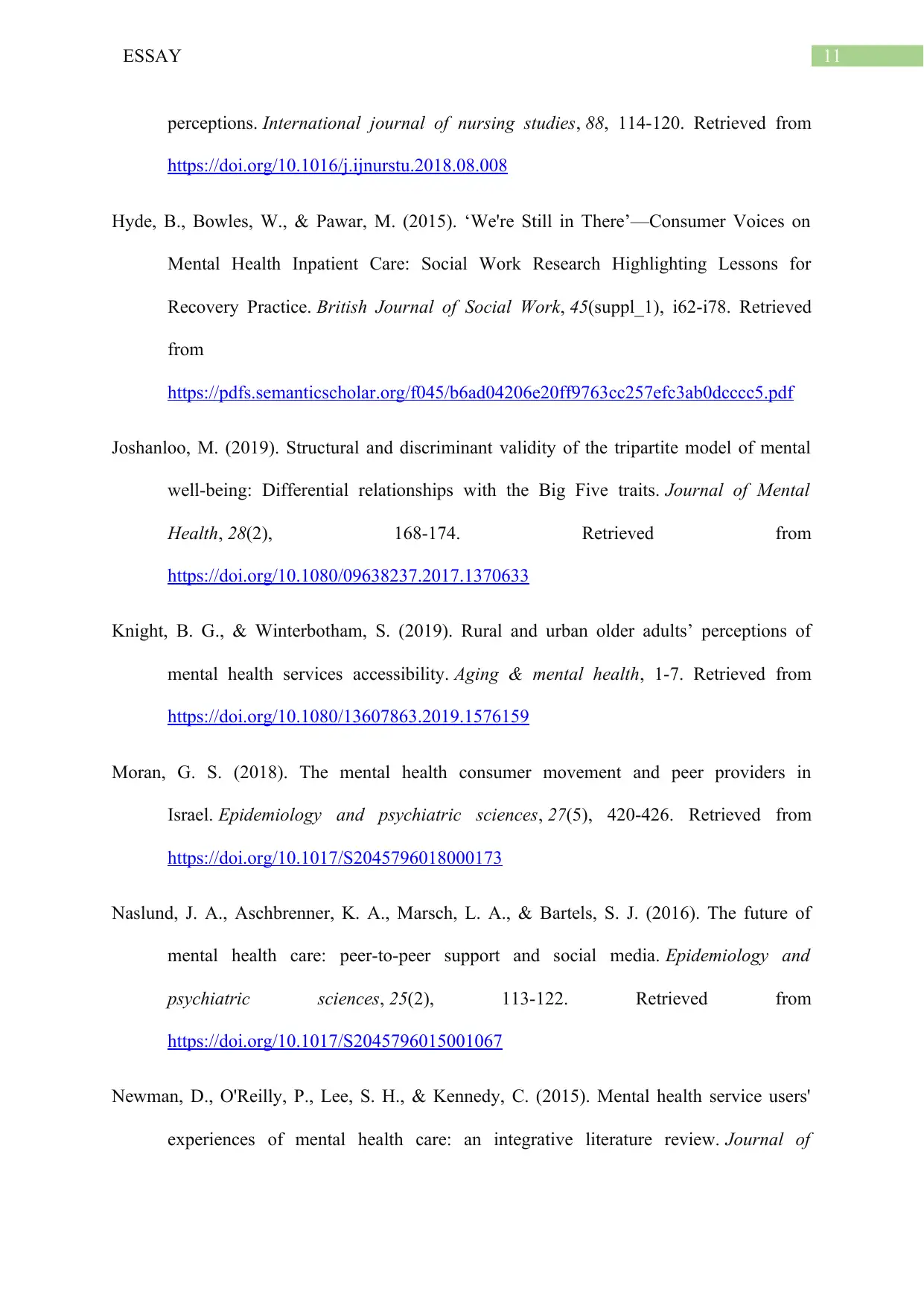
11ESSAY
perceptions. International journal of nursing studies, 88, 114-120. Retrieved from
https://doi.org/10.1016/j.ijnurstu.2018.08.008
Hyde, B., Bowles, W., & Pawar, M. (2015). ‘We're Still in There’—Consumer Voices on
Mental Health Inpatient Care: Social Work Research Highlighting Lessons for
Recovery Practice. British Journal of Social Work, 45(suppl_1), i62-i78. Retrieved
from
https://pdfs.semanticscholar.org/f045/b6ad04206e20ff9763cc257efc3ab0dcccc5.pdf
Joshanloo, M. (2019). Structural and discriminant validity of the tripartite model of mental
well-being: Differential relationships with the Big Five traits. Journal of Mental
Health, 28(2), 168-174. Retrieved from
https://doi.org/10.1080/09638237.2017.1370633
Knight, B. G., & Winterbotham, S. (2019). Rural and urban older adults’ perceptions of
mental health services accessibility. Aging & mental health, 1-7. Retrieved from
https://doi.org/10.1080/13607863.2019.1576159
Moran, G. S. (2018). The mental health consumer movement and peer providers in
Israel. Epidemiology and psychiatric sciences, 27(5), 420-426. Retrieved from
https://doi.org/10.1017/S2045796018000173
Naslund, J. A., Aschbrenner, K. A., Marsch, L. A., & Bartels, S. J. (2016). The future of
mental health care: peer-to-peer support and social media. Epidemiology and
psychiatric sciences, 25(2), 113-122. Retrieved from
https://doi.org/10.1017/S2045796015001067
Newman, D., O'Reilly, P., Lee, S. H., & Kennedy, C. (2015). Mental health service users'
experiences of mental health care: an integrative literature review. Journal of
perceptions. International journal of nursing studies, 88, 114-120. Retrieved from
https://doi.org/10.1016/j.ijnurstu.2018.08.008
Hyde, B., Bowles, W., & Pawar, M. (2015). ‘We're Still in There’—Consumer Voices on
Mental Health Inpatient Care: Social Work Research Highlighting Lessons for
Recovery Practice. British Journal of Social Work, 45(suppl_1), i62-i78. Retrieved
from
https://pdfs.semanticscholar.org/f045/b6ad04206e20ff9763cc257efc3ab0dcccc5.pdf
Joshanloo, M. (2019). Structural and discriminant validity of the tripartite model of mental
well-being: Differential relationships with the Big Five traits. Journal of Mental
Health, 28(2), 168-174. Retrieved from
https://doi.org/10.1080/09638237.2017.1370633
Knight, B. G., & Winterbotham, S. (2019). Rural and urban older adults’ perceptions of
mental health services accessibility. Aging & mental health, 1-7. Retrieved from
https://doi.org/10.1080/13607863.2019.1576159
Moran, G. S. (2018). The mental health consumer movement and peer providers in
Israel. Epidemiology and psychiatric sciences, 27(5), 420-426. Retrieved from
https://doi.org/10.1017/S2045796018000173
Naslund, J. A., Aschbrenner, K. A., Marsch, L. A., & Bartels, S. J. (2016). The future of
mental health care: peer-to-peer support and social media. Epidemiology and
psychiatric sciences, 25(2), 113-122. Retrieved from
https://doi.org/10.1017/S2045796015001067
Newman, D., O'Reilly, P., Lee, S. H., & Kennedy, C. (2015). Mental health service users'
experiences of mental health care: an integrative literature review. Journal of
⊘ This is a preview!⊘
Do you want full access?
Subscribe today to unlock all pages.

Trusted by 1+ million students worldwide
1 out of 14
Related Documents
Your All-in-One AI-Powered Toolkit for Academic Success.
+13062052269
info@desklib.com
Available 24*7 on WhatsApp / Email
![[object Object]](/_next/static/media/star-bottom.7253800d.svg)
Unlock your academic potential
Copyright © 2020–2025 A2Z Services. All Rights Reserved. Developed and managed by ZUCOL.





